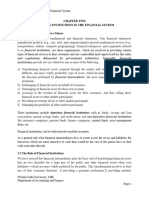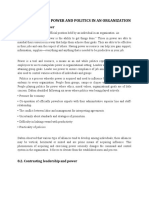0 ratings0% found this document useful (0 votes)
30 viewsChapter Three Financial Institutions in The Financial System
This document discusses financial institutions and how they are classified. It describes depository institutions like commercial banks, savings institutions, and credit unions that accept deposits and make loans. Non-depository institutions are also discussed, including contractual institutions like insurance companies and investment institutions such as mutual funds, finance companies, and real estate investment trusts that sell shares to the public. The document provides details on the services each type of financial institution provides and their roles in the financial system.
Uploaded by
Mikias DegwaleCopyright
© © All Rights Reserved
Available Formats
Download as PPTX, PDF, TXT or read online on Scribd
0 ratings0% found this document useful (0 votes)
30 viewsChapter Three Financial Institutions in The Financial System
This document discusses financial institutions and how they are classified. It describes depository institutions like commercial banks, savings institutions, and credit unions that accept deposits and make loans. Non-depository institutions are also discussed, including contractual institutions like insurance companies and investment institutions such as mutual funds, finance companies, and real estate investment trusts that sell shares to the public. The document provides details on the services each type of financial institution provides and their roles in the financial system.
Uploaded by
Mikias DegwaleCopyright
© © All Rights Reserved
Available Formats
Download as PPTX, PDF, TXT or read online on Scribd
You are on page 1/ 9
Chapter Three
Financial Institutions in the
Financial System
Introduction
•Business entities include nonfinancial and financial
enterprises.
•Nonfinancial enterprises manufacture products (e.g., cars,
steel, computers) and/or provide nonfinancial services
(e.g., transportation, utilities, computer programming).
•On the other hand, financial enterprises, more popularly
referred to as financial institutions, provide services
related to one or more of the following:
Cont’d
A.Transforming financial assets acquired through the market
from depositors to borrowers.
B.Exchanging of financial assets on behalf of customers.
C.Exchanging of financial assets for their own accounts.
D.Assisting in the creation of financial assets for their
customers, and then selling those financial assets to other
market participants.
E.Providing investment advice to other market participants.
F. Managing the portfolios of other market participants.
Cont’d
•Financial intermediaries / institutions may be
classified in a variety of ways.
•One of the most important distinctions is
between Depository and Non-Depository
Intermediaries.
•Below is their basic distinction:
Cont’d
1. Depository Intermediaries
They are the most commonly recognized intermediaries
because most people use their services on a daily basis.
Depository institutions issue a variety of checking or
savings accounts and time deposits and they use the
funds to make consumer, business and mortgage loans.
In other words, they accept deposits from individuals
and firms and use these funds to participate in the debt
market, making loans or purchasing other debt
instruments.
Cont’d
There are several types of depository intermediaries:
commercial banks and nonbank thrift institutions
(near banking institutions) or simply “thrifts” that
comprises saving institutions and credit unions.
Saving institutions include: savings and loan
associations and mutual savings banks.
Mutual savings banks are similar to S&Ls except that
they have more diversified uses of funds.
Cont’d
Whereas commercial banks concentrate on commercial
(business) loans, savings institutions concentrate on
residential mortgage loans.
Credit unions differ from commercial banks and savings
institutions in that they (1) are nonprofit and (2) restrict
their business to credit union members, who share a
common bond (such as a common employer or union).
In addition to accepting deposits, these institutions make
loans and provide other financial services.
Depository institutions are highly regulated because of
the important role that they play in the financial system.
Cont’d
2. Non-Depository Intermediaries
It includes contractual institutions (like insurance companies
and pension funds) and investment institutions (like
investment companies or mutual funds, finance companies,
and real estate investment trusts).
Contractual institutions attract funds by offering legal
contracts to the public in order to protect the savers against
potential risks. (like insurance companies and pension funds)
Investment institutions sell shares to the public and invest the
proceeds in stocks, bonds, and other securities. (like
investment companies or mutual funds, finance companies,
and real estate investment trusts).
Group Assignment (20%-2&3)
1. Discuss about depository and non-depository
financial institutions in Ethiopia
2. Discuss about the following non-depository
financial institutions
A. Investment companies or mutual funds
B. Finance companies and
C. Real estate investment trusts
3. Discuss about the current opportunities and
challenges of the Ethiopian financial institutions.
You might also like
- Depository & Non-Depository Institutions of BD80% (5)Depository & Non-Depository Institutions of BD22 pages
- Chapter2 Two Financial Institutions in The Financial SystemNo ratings yetChapter2 Two Financial Institutions in The Financial System72 pages
- Chapter Two Financial Institutions in The Financial SystemNo ratings yetChapter Two Financial Institutions in The Financial System75 pages
- C - T 3. D N - D F I: Hapter Hree Eposit Taking and ON Eposit Taking Inancial NstitutionsNo ratings yetC - T 3. D N - D F I: Hapter Hree Eposit Taking and ON Eposit Taking Inancial Nstitutions15 pages
- Chapter Two Financial Institutions in The Financial SystemNo ratings yetChapter Two Financial Institutions in The Financial System75 pages
- Ch. 1 Introduction To Financial InstitutionsNo ratings yetCh. 1 Introduction To Financial Institutions45 pages
- Debre Markos Universty College of Post-Graduate Studies Department of Accounting and FinanceNo ratings yetDebre Markos Universty College of Post-Graduate Studies Department of Accounting and Finance14 pages
- Role of Financial Institutes in FinanciaNo ratings yetRole of Financial Institutes in Financia18 pages
- CH 3- Financial Economics - LECTURE NoteNo ratings yetCH 3- Financial Economics - LECTURE Note26 pages
- Financial Institutions in The Financial System100% (1)Financial Institutions in The Financial System15 pages
- Chapter2. Financial Inst&capital ArketsNo ratings yetChapter2. Financial Inst&capital Arkets12 pages
- Financial Institutions: A Financial Institution (FI) Is A Company Engaged in The BusinessNo ratings yetFinancial Institutions: A Financial Institution (FI) Is A Company Engaged in The Business20 pages
- Lesson 4: Lending and Borrowing in The Financial System (Part II)No ratings yetLesson 4: Lending and Borrowing in The Financial System (Part II)6 pages
- Banks and Other Financial IntermediariesNo ratings yetBanks and Other Financial Intermediaries3 pages
- MGMT of Financial Inistitutions - Chapter 1No ratings yetMGMT of Financial Inistitutions - Chapter 191 pages
- T1C1-3 - Role of Financial Markets and InstitutionsNo ratings yetT1C1-3 - Role of Financial Markets and Institutions22 pages
- International Trade Finance: A NOVICE'S GUIDE TO GLOBAL COMMERCEFrom EverandInternational Trade Finance: A NOVICE'S GUIDE TO GLOBAL COMMERCENo ratings yet
- Financial Markets Fundamentals: Why, how and what Products are traded on Financial Markets. Understand the Emotions that drive TradingFrom EverandFinancial Markets Fundamentals: Why, how and what Products are traded on Financial Markets. Understand the Emotions that drive TradingNo ratings yet
- Tactical Objective: Strategic Maneuvers, Decoding the Art of Military PrecisionFrom EverandTactical Objective: Strategic Maneuvers, Decoding the Art of Military PrecisionNo ratings yet
- Chapter Two-Foundation of Individual Behavior and Learning in An OrganizationNo ratings yetChapter Two-Foundation of Individual Behavior and Learning in An Organization14 pages
- Chapter Seven-Organizational Culture and Diversity100% (1)Chapter Seven-Organizational Culture and Diversity7 pages
- Chapter Three Foundation of Group Behavior: 1.1. Defining and Classifying Team And/or Group100% (1)Chapter Three Foundation of Group Behavior: 1.1. Defining and Classifying Team And/or Group17 pages
- Chapter Four: Investment/Project Appraisal - Capital BudgetingNo ratings yetChapter Four: Investment/Project Appraisal - Capital Budgeting40 pages
- Chapter Two-Foundation of Individual Behavior and Learning in An OrganizationNo ratings yetChapter Two-Foundation of Individual Behavior and Learning in An Organization16 pages
- 1.1. What Is Stress?: Chapter Six-Stress ManagementNo ratings yet1.1. What Is Stress?: Chapter Six-Stress Management6 pages
- Chapter Eight - Power and Politics in An OrganizationNo ratings yetChapter Eight - Power and Politics in An Organization4 pages
- Chapter Six: Risk Management in Financial InstitutionsNo ratings yetChapter Six: Risk Management in Financial Institutions22 pages
- Advanced Corporate Finance (ACFN - 551) (Credit Hours: 3) : Departmet of Accounting and FinanceNo ratings yetAdvanced Corporate Finance (ACFN - 551) (Credit Hours: 3) : Departmet of Accounting and Finance85 pages
- Chapter Five: Interest Rate Determination and Bond ValuationNo ratings yetChapter Five: Interest Rate Determination and Bond Valuation38 pages
- Chapter Three: Dividend Decision/PolicyNo ratings yetChapter Three: Dividend Decision/Policy38 pages
- Chapter Two: Financing Decisions / Capital StructureNo ratings yetChapter Two: Financing Decisions / Capital Structure72 pages
- Chapter Four Financial Markets in The Financial SystemNo ratings yetChapter Four Financial Markets in The Financial System66 pages
- Chapter Five Regulation of Financial Markets and Institutions and Financial InnovationNo ratings yetChapter Five Regulation of Financial Markets and Institutions and Financial Innovation22 pages
- Financial Institutions and Market: (ACFN, 2 Credit Hour)No ratings yetFinancial Institutions and Market: (ACFN, 2 Credit Hour)25 pages
- Quantitative Trading Using Deep Q LearningNo ratings yetQuantitative Trading Using Deep Q Learning10 pages
- Global Financial Crisis and Kerala EconomyNo ratings yetGlobal Financial Crisis and Kerala Economy16 pages
- AQR (2014) Capital Market Assumptions For Major Asset ClassesNo ratings yetAQR (2014) Capital Market Assumptions For Major Asset Classes12 pages
- AS Chakravarthy NCFM: Equity Derivatives Exam Model Paper (NISM-8)No ratings yetAS Chakravarthy NCFM: Equity Derivatives Exam Model Paper (NISM-8)31 pages
- A Comparative Study On Mutual Funds in Thane. Doc Black Book Waheed ShaikhNo ratings yetA Comparative Study On Mutual Funds in Thane. Doc Black Book Waheed Shaikh75 pages
- Estimating Liquidity Risk Using The Exposure Based Cash Flow at Risk Approach An Application To The Uk Banking Sector - AcceptedNo ratings yetEstimating Liquidity Risk Using The Exposure Based Cash Flow at Risk Approach An Application To The Uk Banking Sector - Accepted27 pages
- Outsourced Chief Investment Officer (OCIO) - Details, Activities and BenefitsNo ratings yetOutsourced Chief Investment Officer (OCIO) - Details, Activities and Benefits4 pages
- IB Business Management Average Rate of Return (ARR)No ratings yetIB Business Management Average Rate of Return (ARR)2 pages
- Goldman Exhibits - Hearing On Wall Street and Financial Crisis100% (1)Goldman Exhibits - Hearing On Wall Street and Financial Crisis901 pages
- ISS-EVA-Downgrades-COSTCO-WHOLESALE-CORP-to-HOLD 03292024No ratings yetISS-EVA-Downgrades-COSTCO-WHOLESALE-CORP-to-HOLD 032920247 pages
- Global Banking Coursework Report - Group 7-2No ratings yetGlobal Banking Coursework Report - Group 7-213 pages
- Financial Analysis of Amalgamation Between TCS CMC A Project Report PDFNo ratings yetFinancial Analysis of Amalgamation Between TCS CMC A Project Report PDF16 pages
- Assignment 1:: Secutrities Analysis & Portfolio ManagementNo ratings yetAssignment 1:: Secutrities Analysis & Portfolio Management37 pages
- NET PRESENT VALUE AND OTHER INVESTMENT CRITERIA - Chapter 08100% (1)NET PRESENT VALUE AND OTHER INVESTMENT CRITERIA - Chapter 0816 pages
- Market Microstructure: Information-Based ModelsNo ratings yetMarket Microstructure: Information-Based Models8 pages
- Chapter2 Two Financial Institutions in The Financial SystemChapter2 Two Financial Institutions in The Financial System
- Chapter Two Financial Institutions in The Financial SystemChapter Two Financial Institutions in The Financial System
- C - T 3. D N - D F I: Hapter Hree Eposit Taking and ON Eposit Taking Inancial NstitutionsC - T 3. D N - D F I: Hapter Hree Eposit Taking and ON Eposit Taking Inancial Nstitutions
- Chapter Two Financial Institutions in The Financial SystemChapter Two Financial Institutions in The Financial System
- Debre Markos Universty College of Post-Graduate Studies Department of Accounting and FinanceDebre Markos Universty College of Post-Graduate Studies Department of Accounting and Finance
- Financial Institutions: A Financial Institution (FI) Is A Company Engaged in The BusinessFinancial Institutions: A Financial Institution (FI) Is A Company Engaged in The Business
- Lesson 4: Lending and Borrowing in The Financial System (Part II)Lesson 4: Lending and Borrowing in The Financial System (Part II)
- T1C1-3 - Role of Financial Markets and InstitutionsT1C1-3 - Role of Financial Markets and Institutions
- International Trade Finance: A NOVICE'S GUIDE TO GLOBAL COMMERCEFrom EverandInternational Trade Finance: A NOVICE'S GUIDE TO GLOBAL COMMERCE
- Financial Markets Fundamentals: Why, how and what Products are traded on Financial Markets. Understand the Emotions that drive TradingFrom EverandFinancial Markets Fundamentals: Why, how and what Products are traded on Financial Markets. Understand the Emotions that drive Trading
- Tactical Objective: Strategic Maneuvers, Decoding the Art of Military PrecisionFrom EverandTactical Objective: Strategic Maneuvers, Decoding the Art of Military Precision
- Chapter Two-Foundation of Individual Behavior and Learning in An OrganizationChapter Two-Foundation of Individual Behavior and Learning in An Organization
- Chapter Seven-Organizational Culture and DiversityChapter Seven-Organizational Culture and Diversity
- Chapter Three Foundation of Group Behavior: 1.1. Defining and Classifying Team And/or GroupChapter Three Foundation of Group Behavior: 1.1. Defining and Classifying Team And/or Group
- Chapter Four: Investment/Project Appraisal - Capital BudgetingChapter Four: Investment/Project Appraisal - Capital Budgeting
- Chapter Two-Foundation of Individual Behavior and Learning in An OrganizationChapter Two-Foundation of Individual Behavior and Learning in An Organization
- 1.1. What Is Stress?: Chapter Six-Stress Management1.1. What Is Stress?: Chapter Six-Stress Management
- Chapter Eight - Power and Politics in An OrganizationChapter Eight - Power and Politics in An Organization
- Chapter Six: Risk Management in Financial InstitutionsChapter Six: Risk Management in Financial Institutions
- Advanced Corporate Finance (ACFN - 551) (Credit Hours: 3) : Departmet of Accounting and FinanceAdvanced Corporate Finance (ACFN - 551) (Credit Hours: 3) : Departmet of Accounting and Finance
- Chapter Five: Interest Rate Determination and Bond ValuationChapter Five: Interest Rate Determination and Bond Valuation
- Chapter Two: Financing Decisions / Capital StructureChapter Two: Financing Decisions / Capital Structure
- Chapter Four Financial Markets in The Financial SystemChapter Four Financial Markets in The Financial System
- Chapter Five Regulation of Financial Markets and Institutions and Financial InnovationChapter Five Regulation of Financial Markets and Institutions and Financial Innovation
- Financial Institutions and Market: (ACFN, 2 Credit Hour)Financial Institutions and Market: (ACFN, 2 Credit Hour)
- AQR (2014) Capital Market Assumptions For Major Asset ClassesAQR (2014) Capital Market Assumptions For Major Asset Classes
- AS Chakravarthy NCFM: Equity Derivatives Exam Model Paper (NISM-8)AS Chakravarthy NCFM: Equity Derivatives Exam Model Paper (NISM-8)
- A Comparative Study On Mutual Funds in Thane. Doc Black Book Waheed ShaikhA Comparative Study On Mutual Funds in Thane. Doc Black Book Waheed Shaikh
- Estimating Liquidity Risk Using The Exposure Based Cash Flow at Risk Approach An Application To The Uk Banking Sector - AcceptedEstimating Liquidity Risk Using The Exposure Based Cash Flow at Risk Approach An Application To The Uk Banking Sector - Accepted
- Outsourced Chief Investment Officer (OCIO) - Details, Activities and BenefitsOutsourced Chief Investment Officer (OCIO) - Details, Activities and Benefits
- IB Business Management Average Rate of Return (ARR)IB Business Management Average Rate of Return (ARR)
- Goldman Exhibits - Hearing On Wall Street and Financial CrisisGoldman Exhibits - Hearing On Wall Street and Financial Crisis
- ISS-EVA-Downgrades-COSTCO-WHOLESALE-CORP-to-HOLD 03292024ISS-EVA-Downgrades-COSTCO-WHOLESALE-CORP-to-HOLD 03292024
- Financial Analysis of Amalgamation Between TCS CMC A Project Report PDFFinancial Analysis of Amalgamation Between TCS CMC A Project Report PDF
- Assignment 1:: Secutrities Analysis & Portfolio ManagementAssignment 1:: Secutrities Analysis & Portfolio Management
- NET PRESENT VALUE AND OTHER INVESTMENT CRITERIA - Chapter 08NET PRESENT VALUE AND OTHER INVESTMENT CRITERIA - Chapter 08













































































































